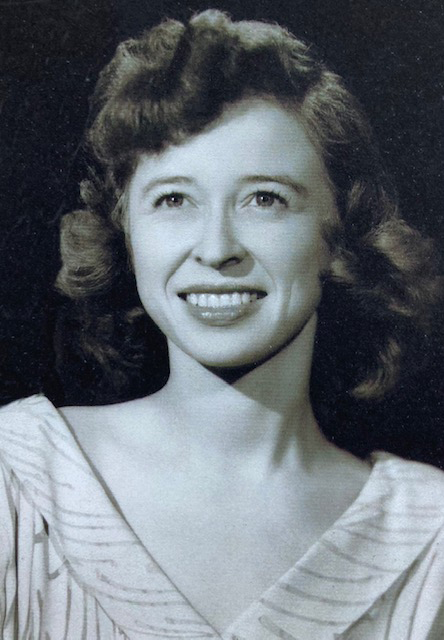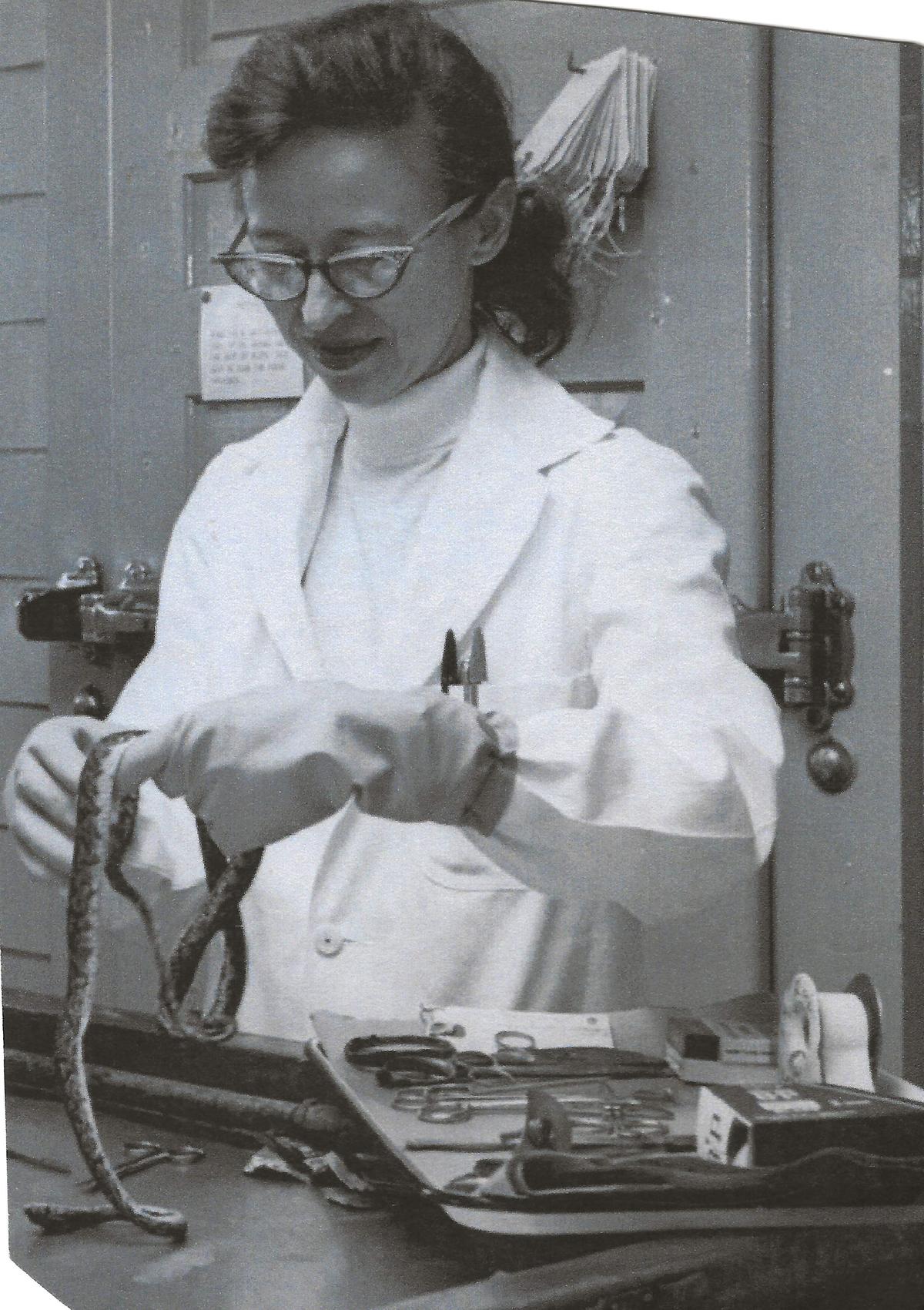For decades, Dr. Joan Parent of Foley ‒ who came in 1945 ‒ has been known as Minnesota’s first female practitioner. But a 2005 book reveals that Dr. Parent had a predecessor here, Dr. Louise Ann Scherger, who practiced in Minneapolis from 1944 to 1945.
We give more detail below about Drs. Scherger and Parent. And we give a few details on Scherger’s employer, Dr. Ora Morgan. Finally, we describe the work of Lesley Ann Gentry, the researcher who brought Scherger’s work in Minnesota to light.
Dr. Louise Ann Scherger
Dr. Scherger, a Kansas native who received her veterinary degree from Kansas State in September, 1944, came to Minneapolis and practiced for a year at the Morgan Animal Hospital, at 2544 Lyndale Avenue South.
Leaving Minneapolis in 1945, Scherger moved on to Nebraska and Wisconsin. She married Charles M. Lombard in 1948 and changed her name to Louise Ann Lombard. She earned a Ph.D. in pathology from the University of Wisconsin in 1950 and continued her career as a pathologist. She died in California in 1987.
Dr. Joan Parent
A native of Ontario, Dr. Parent graduated from Ontario Veterinary College in the spring of 1945 and came to Foley, Minnesota, in November to practice with her classmate and husband, Murray Parent, and his father, Xavier. She worked with her husband on both large and small animal cases, then left practice to raise children. When her husband died in 1973, she decided to retire rather than re-enter the profession. An advocate for female sports and education, Parent eventually became president of the Minnesota School Board Association and the National School Boards Association. She died in Minnesota in 2013.
Dr. Ora Morgan and the Morgan Animal Hospital
Dr. Ora Morgan, a 1914 graduate of Kansas State, brought Dr. Louise Scherger to Minneapolis. Dr. Eugene Porter of Minneapolis remembers Dr. Morgan and believes that his Lyndale avenue hospital was the first building in Minneapolis to be designed and built as a small animal clinic.
Morgan’s practice seems to have had more than its share of interesting and unusual events, including:
1929: Morgan is the defendant in what was called “the first case of alleged canine malpractice to be tried in Hennepin county” when a client unsuccessfully sues him for malpractice in treating a dog. This was several years before the Lyndale Avenue clinic was built, and Dr. Morgan was practicing at 908 W. Lake St.
1929: a German Shepherd that had been treated at the Morgan hospital is subsequently stolen, then escapes its captors and makes its way to the Lake Street hospital. There, it scratches on the front door until admitted, is recognized by the staff, and returned to its owners.
1936: Dr. Morgan builds and opens his hospital on Lyndale Avenue in August. Three weeks after the clinic opens, Morgan’s permit to operate a veterinary facility is denied by the city of Minneapolis health and hospitals committee, reportedly because “neighbors have protested against alleged howling of dogs and odors emanating from the hospital.” The city council soon reverses the decision, and to prevent similar dilemmas in the future, it resolves that any required business permits must be approved before building permits are issued.
1940: Dr. Morgan treats Peter the Great, a boxing kangaroo, after a short section of the kangaroo’s tail is accidently amputated when an elevator door is closed on it and the elevator moved at the Minneapolis auditorium. The case has a poor outcome. Peter the Great dies, according to its owners, of gangrene caused by the amputation, and the owners sue the city-owned auditorium for the loss. Dr. Ruel Fenstermacher of the University of Minnesota, however, testifies that he found no evidence of gangrene at necropsy, and attributes the death to pneumonia.
1943: a court case involving a $135 dog boarding charge between Dr. Morgan and a client progresses all the way to the Minnesota Supreme Court. The court decides for the client and awards Morgan only the original $11 medical charge.
1957: an employee of the Morgan hospital shoots and kills veterinarian Clarence Penticuff and wounds another employee at the clinic before taking his own life.
Dr. Morgan died at his home in Edina in 1964. The original 1936 Morgan Hospital building still stands on South Lyndale Avenue and is operated today as the Lyndale Animal Hospital.
Lesley Ann Gentry
An interest in early Kansas veterinarians stimulated Lesley Ann Gentry to write the book that brought Louise Ann Scherger to our attention. Gentry, a native of England, met veterinarian Robert H. Gentry, Kansas class of 1981, in Berkshire where she was a veterinary nurse and he was veterinary student intern at the Veterinary Surgery, Wokingham, Berkshire. The two married in Kansas and purchased the Beloit Veterinary Clinic in that state, which they operated from 1983 to 2005.
In 2005, Gentry published The Lady is a Veterinarian, a history of the earliest women to graduate from the Kansas State College School of Veterinary Medicine. Seven men constituted Kansas State’s first veterinary class, which graduated in 1907. The first woman, Helen Richt of Omaha, graduated in 1932, followed by Louise Sklar in 1934. Sklar, a precocious student, graduated with her D.V.M. at age 19 and is considered the youngest woman to graduate from a veterinary program.
Since publishing The Lady is a Veterinarian Gentry has written Embracing the Equine Profession: The Story of Dr. Olive Kendrick Britt, published in 2012, and has presented numerous papers at veterinary history conferences. She is a well-trained genealogist as well.
“My passion for veterinary history started with an idea in about 2000” Gentry wrote in a recent email to the museum. “I wanted to know more about the pioneer veterinarians in Kansas, who they were, where they came from etc. I stumbled across a half paragraph about the first female veterinarian to qualify in Kansas and felt she deserved more than a mention. I have written and spoken about women in veterinary medicine ever since. It was not my intention to just write about women as I have written about male veterinarians also. . . . It is fascinating for young veterinary students (many women these days) to hear about the pioneers.”
The Minnesota Veterinary Historical Museum gratefully acknowledges the kind assistance of Lesley Ann Gentry, who reviewed a draft of this article, provided the photographs of Dr. Scherger, and shared her documentation of Scherger’s work in Minneapolis.
Paul Maravelas

